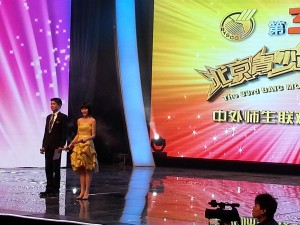Steve: What If Science Competitions Were More Like the Oscars?
During the week of March 19-26, four high school students selected by Science, Math, and Technology Education Center to participate in the North Carolina International Science Competition (NCISC) are traveling to Beijing, China to present their research, meet students from other countries, and experience Chinese culture. This blog highlights the journey of these future science rockstars of North Carolina! Today, we hear from one of the adult travelers on the trip, Steve Hill who is Executive Director of North Carolina’s Eastern Region: STEM East. See more pictures and updates on Facebook, Twitter, and Instagram.
The grand opening of the Science Competition reminded me of an evening at the Oscars. The production of the event was far beyond anything I have seen in the US to celebrate scientific achievement. The show-like quality of the event made me think that our students may begin to be more excited about science if we provided such enthusiasm toward their research. At the conclusion of the program a large floating container was brought to the middle of the stage where many dignitaries took what I considered “superman movie” crystals and placed them like keys into the floating platform. With a great volume of fanfare, music and an explosion of golden confetti shot out across the entire theater.
The science contestants delivered high quality research presentations. We visited with students from all around the world and saw teenage students experimenting with robotics, environmental protection, engineering projects and much more. Standouts included an automatic safety brake for baby strollers built by the Singapore students and algae-based sunscreen designed by a team from Denmark. Of course, our American students research delivered as well with four gold medals.
The most encouraging action witnessed was the camaraderie demonstrated by all the students from around the world. As adults we can learn a lot from watching these students ignore all political and cultural differences to become friends and discuss their work openly with each other. The students exchanged information and vowed to stay in touch with each other.
The school officials delivered on venue here as well with a large modern enclosed display arena that was pointed out to the public through advertising billboards across the city. The marketing campaign concluded at the steps of the science competition arena with large billboards and demo cars from a sponsoring car manufacturer. As evening arrived the arena was lite with neon lights much like commercial buildings in the US.
The closing ceremonies did not disappoint. It contained Broadway-quality dance and singing numbers and even opened with a full traditional Chinese orchestra. Again, education is highly praised in China and is celebrated at levels unseen in America. The winning Chinese students received plaques from the Beijing Mayor that guaranteed them acceptance into respected universities and exempted them from the national exams.
Upon leaving, our group has agreed to stay in contact and lobby for more attention to be given to the STEM courses and students.
It was with these images in mind that I watched my child compete in a regional history research competition within a major university the same day I returned from China. I remembered the fanfare and honor given to the Chinese students as we placed her display on plain tables in the basement of the university. I especially remembered the Chinese closing ceremonies as my daughter was called to an unadorned stage for winning second place, which moved her forward to state competition. She was handed a simple red ribbon and immediately sent back to her seat.
If we make STEM exciting and important then the students will view pursuing achievements in STEM exciting and important. Maybe if we make STEM competitions equally as exciting as our US sporting events and give high achievers the recognition they deserve US students will enroll in STEM curriculum in much greater numbers.

